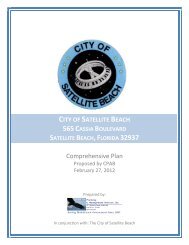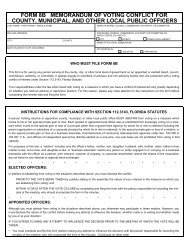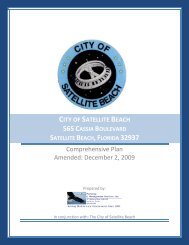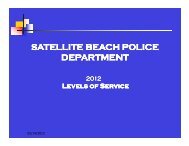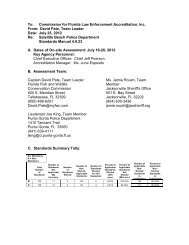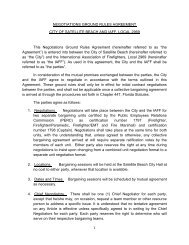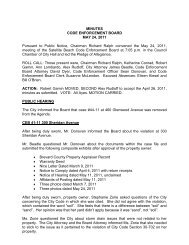Supporting Documents (Data and Analysis) - Satellite Beach
Supporting Documents (Data and Analysis) - Satellite Beach
Supporting Documents (Data and Analysis) - Satellite Beach
Create successful ePaper yourself
Turn your PDF publications into a flip-book with our unique Google optimized e-Paper software.
Inadequacies in portions of the City's stormwater conveyance system cause some street flooding for<br />
brief periods after heavy rainfall. The City has identified problem locations <strong>and</strong> has underway an<br />
ongoing program of improvements. In planning to alleviate flooding, the City is addressing the dual<br />
considerations of stormwater removal <strong>and</strong> improvement of estuarine water quality by retrofitting<br />
existing systems <strong>and</strong> implementing best management practices in cooperation with the St. Johns<br />
River Water Management District.<br />
Estuarine Pollution<br />
The principal source of estuarine pollution originating within the City is "first-flush" of organic <strong>and</strong><br />
metallic materials from streets <strong>and</strong> parking areas <strong>and</strong> nutrients <strong>and</strong> pesticides from residential<br />
l<strong>and</strong>scapes entering the City's stormwater drainage system. These then discharge into finger canals,<br />
which flow into the Gr<strong>and</strong> Canal. Improvement of estuarine pollution resulting from stormwater<br />
outfalls is a concern of the City <strong>and</strong> the St. Johns River Water Management District. The City has<br />
adopted on-site stormwater regulations for private development activities. In addition, siltation is an<br />
important source of pollution. This information is elaborated on in the Infrastructure Element of the<br />
Plan. Regulations currently in place <strong>and</strong> limited opportunities for future l<strong>and</strong> development within the<br />
City (primarily residential uses) will eliminate any significant potential for increases in estuarine<br />
pollution.<br />
Well-water Discharge<br />
Well-water discharge contributes to the City's drainage. Well water empties into finger canals from a<br />
few remaining antiquated water-to-air air conditioner units. State law requires that water withdrawn<br />
from the Floridan Aquifer for heat exchange purposes be injected back into the Aquifer through a<br />
separate well, <strong>and</strong> City ordinances prohibit direct discharge of well water into the City's stormwater<br />
drainage system. To the degree that these laws <strong>and</strong> ordinances are enforced, well water discharge<br />
will occur only as sheet flow across lawns from shallow wells. As best as is known, the City has no<br />
problem with well water discharges into the City's stormwater system.<br />
In addition to flow from wells serving water-to-air air conditioners, well water used to irrigate lawns<br />
that does not evaporate or is not transpired by plants into the atmosphere enters the surficial aquifer<br />
at the water table. Water from free-flowing wells tapping the artesian Upper Floridan Aquifer that<br />
have failed below the surface of the ground (normally due to the iron well casing corroding through<br />
due to sulfuric acid in the well water (from dissolved sulfur dioxide)) also enters the surficial aquifer.<br />
This water then flows down-gradient until it encounters the bank of an open water body. With the<br />
network of drainage canals in the City draining into the Gr<strong>and</strong> Canal in the western portion of the<br />
City, the groundwater almost inevitably seeps into the canals. This below-grade flow may be<br />
substantially more than the sheet flow <strong>and</strong> point discharges from pipes. Statistical analysis of ionic<br />
ratios in water samples collected at stormwater outfalls in the City in 1999 suggests that about 40%<br />
of the water in those samples had originated in the Upper Floridan Aquifer. Statistical analysis of the<br />
discharge from the DeSoto drainage basin versus rainfall for 2½ months in late 2001 suggests about<br />
one third of the water leaving that drainage basin at that time did not come from rain. Since the<br />
amount of potable Melbourne water discharged outside homes is negligible, this leaves water from<br />
wells as the likely source of this extra flow. These analyses are preliminary <strong>and</strong> do not constitute<br />
Coastal Management/Conservation Element<br />
<strong>Data</strong> <strong>and</strong> <strong>Analysis</strong> 5-8



